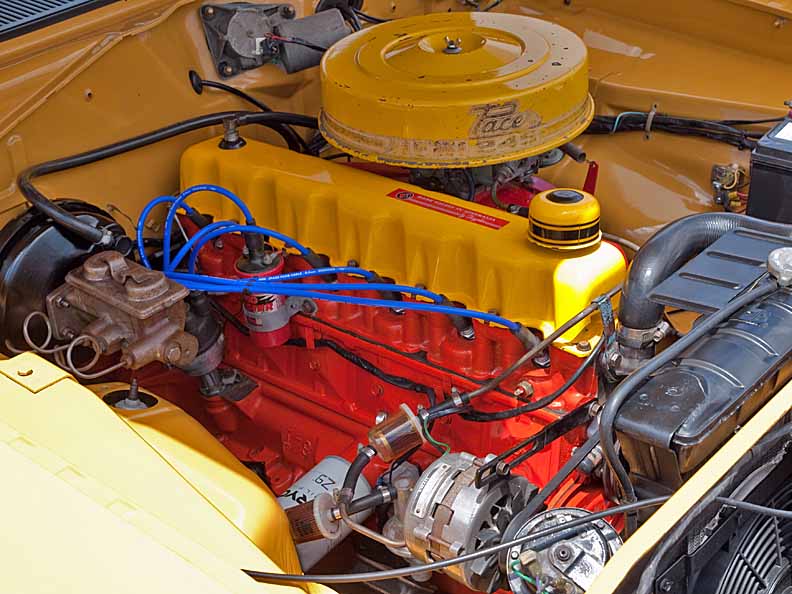
Grant Musker's 1970 Aussie Hemi Six VG Valiant Pacer

1. An unusual Valiant -- for car shows in the States -- showed up at the 2017 Chrysler Nationals at Carlisle, PA, in July, and then again at a Mopar date at Englishtown later in the summer: a six-cylinder 1970 Pacer Valiant from New Zealand. Manufactured by Chrysler Australia, the car was, and is, powered by a six-cylinder "Hemi" engine of 245 cubic inches that is a departure from the Slant Six familiar in Valiants and Mopar vehicles made in America. The block rises, and pistons move, straight up and down. Owner of the car is Grant Musker who hails from Auckland, New Zealand. He and his wife are in the states for an extended stay. He is a mechanic and his wife works in the pharmaceuticals industry.

2. New South Wales, New Zealand, plate, KSO-760. Owner Musker reports: "The car was originally sold new in Melbourne, Australia. It sat for 15 years garaged in Brisbane, where I purchased it in 2009. I spent a year going through it bringing it up to a drivable standard. EventualIy I shipped the car to my family home in Auckland, New Zealand, in 2014." Color name: Hot Mustard. What, no sideview mirror on the passenger side?

3. Right-hand drive, Slant Six-powered Valiants introduced in Australia in 1962 were first assembled using parts from the U.S. and Canada. Because Slant Sixes wouldn't scale up in cubic inches to power future car models requiring larger engines, Chrysler Australia decided to develop an all new six-cylinder engine of its own. The engineering design team in Detroit referenced earlier studies in developing prototypes to hand over to the division "down under" for its use in finishing the project. Production of the upright Hemi Six began in 1969. Grant's car is the "sport" version of three cars Chrysler Australia used in its production circuit-racing program; two other versions got increasing performance engineering. All versions had bucket seats, standard transmission, disc brakes, sway bar, performance exhaust, stripe package and other options.

4. Grant rebuilt the engine after he bought it fixing a rear main seal leak and boosting its pep. He built it to a specification, E49, defined for Australian Charger race cars that competed throughout the 1970s: a special cam, heavy-duty springs, double-row timing chain, etc. The car came with some porting done previously. E49 also specifies triple Weber side draft carburetors and header. Grant plans to add those over the coming winter (1917-18). American Slant Six owners will recognize the engine's manifolds as they are a match for the manifolds in the American engines.

5. Grant and his wife are living in Pennsylvania where the car is registered. "We moved from Australia to the States", Grant explains, "for my wife's job in the States and my love of cars." Will you work as a mechanic; is that actually your line, or do you have some other vocation. What town, or general area? What do you tow? Looks like a roomy trunk. What does the C in CHEMI6 stand for? Will you race the car? Have you become associated with any American clubs? What are your plans for showing the car? Would the Hemi 245 not benefit from dual exhausts?

6. Wide, Charger-like grille, rectangular headlights. The red stripe is a nice touch. What else to say about the styling. I see some stateside 1970 Dodge Charger grille styling in it, or at least an Australian adaptation. Direction of wipers is reversed.

7. Comparing the 1970 Pacer Valiant with Dave Zatz's 1974 Plymouth Valiant, mid-section of the two cars is quite similar. The front of the hood (bonnet?) curves in a wide roll down to the grill, and running lights are flush in fenders. Aft, the roof is slightly more angular as it drops to the trunkline.

8. "Driving a right-hand drive car hasn't been difficult at all," Grant says. "There are really no negatives. But on the right hand side of the road, regardless of the car, did take some time and was a little scary at first. Some mistakes were made when tired or distracted, but both me and my wife are fine with it, now."